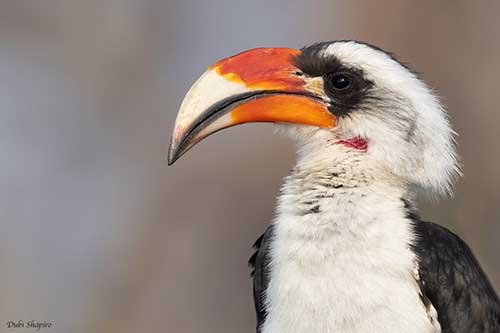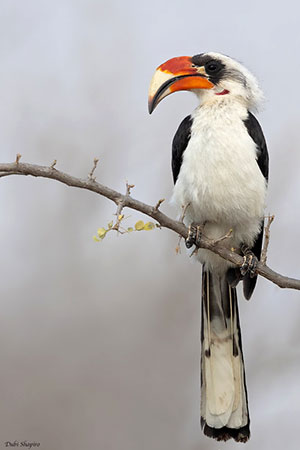
Fr: Calao de der Decken
Ang: Von der Decken's Hornbill
All: Von-der-Decken-Toko
Esp: Toco de Von der Decken
Ita: Bucero di Von der Decken
Nd: Von der Deckens Tok
Sd: savanntoko
Photographers:
Jean Michel Fenerole
Photos d’Oiseaux du monde
Ken Havard
My Bird Gallery & Flickr gallery 1 & Flickr gallery 2
Patrick Ingremeau
TAMANDUA
Tom Merigan
Tom Merigan’s Photo Galleries
Dubi Shapiro
Dubi Shapiro Photo Galleries
Simon Tan
PBase Bird galleries
Text by Nicole Bouglouan
Sources:
HANDBOOK OF THE BIRDS OF THE WORLD Vol 6 by Josep del Hoyo-Andrew Elliott-Jordi Sargatal - Lynx Edicions, 2001 - ISBN: 848733430X
BIRDS OF AFRICA SOUTH OF THE SAHARA by Ian Sinclair and Peter Ryan - Princeton University Press Princeton and Oxford - ISBN: 0691118159
Birds of Kenya's Rift Valley De Adam Scott Kennedy - Princeton University Press, 2014 – ISBN: 1400851378, 9781400851379 – 256 pages
Wikipedia, the free encyclopaedia
Von der Decken's Hornbill
Tockus deckeni
Bucerotiformes Order – Bucerotidae Family
INTRODUCTION:
The Von der Decken's Hornbill is endemic to East Africa, from Ethiopia S to Tanzania. It frequents acacia thickets and thorn scrubs where it feeds on insects, fruits and seeds. It forages mainly on the ground.
This species typically nests in tree cavities where the female remains with the chicks while the male provides them all the food.
The Von der Decken's Hornbill is described as widespread and locally common, and currently, the species is not globally threatened.
The name of this hornbill pays tribute to the German explorer Baron Karl Klaus von der Decken (1833-1865).
DESCRIPTION OF THE BIRD:
Biometrics:
Length: 47 cm
Weight: M: 165-212 g – F: 120-155 g
The Von der Decken's Hornbill adult male is a medium-sized hornbill with white back, wing patches and outer rectrices.
Wings and wing-coverts are black except the white middle secondaries and middle great coverts. The tail is long and rectangular, with black central rectrices.
The underparts are white. We can see a pinkish patch of bare skin on the throat.

The head is mostly white with black patch on forehead and crown extending in black stripe until the nape, and a conspicuous, broad black eye-patch.
The large, thick, down-curved bill is red with pale yellow to whitish outer half and dark cutting edges. The eyes are brown, surrounded by black bare skin. Legs and feet are dark grey.
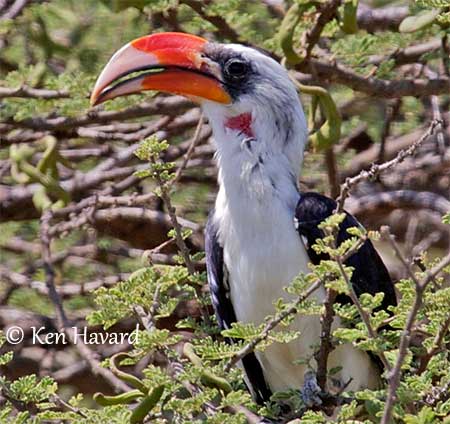
The female is smaller. She has similar plumage but her bill is smaller and entirely black. She also has a pinkish patch of bare skin on the throat.
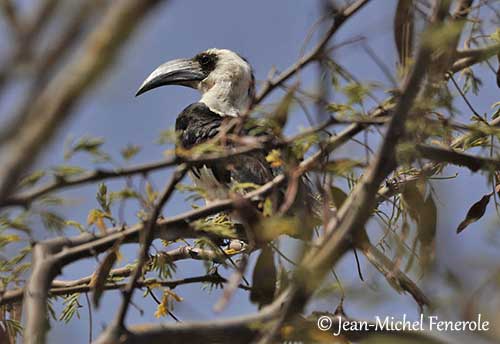
The juvenile has paler eyes than adults, mostly pale grey-brown. The bill is smaller, dark horn with yellow or orange patches.
On the upperwing, the wing-coverts are spotted white.
RANGE:
The Von der Decken's Hornbill is found in East Africa, in parts of Ethiopia, mainly in and E of the Rift Valley, Somalia, Kenya (except NE) and C Tanzania.
HABITAT:
The Von der Decken's Hornbill usually lives in arid regions such as scrublands, savannas, open bush habitats and woodland with thorn trees.
The species is visible up to 1,500 metres of elevation in Ethiopia.
CALLS AND SONGS: SOUNDS BY XENO-CANTO
The Von der Decken's Hornbill gives loud, monotonous cackling-notes. This sound is described as “roh-roh-roh-roh-roh-rho-RAH-RAH-RAH-RHA”
The bird may utter a single note, but during the displays, this sound may break into laughter.
The call is also described as a low-pitched, monotonous “wuk-wuk-wuk-wuk-wuk”.
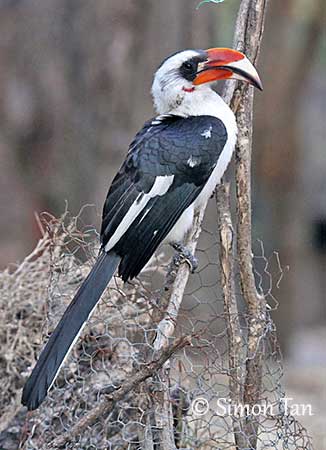
BEHAVIOUR IN THE WILD:
The Von der Decken's Hornbill feeds mainly on insects such as grasshoppers, locusts, beetles and their larvae, termites and ants. But other prey such as snails, mice, nestling birds, lizards and tree frogs are also part of the diet. Depending on the season, it also eats seeds and berries.
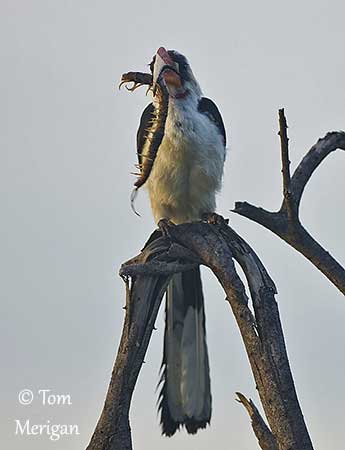
Another typical hornbill’s behaviour is reported.
The Von der Decken's Hornbill and the Dwarf Mongoose (Helogale undulata) have established a relationship, probably a mutual benefit to help them to forage efficiently.
The mongooses flush out insects for the hornbills, while the birds provide them protection and vigilance against approaching predators. This behaviour allows the mongooses more time to feed in termitaria in the arid savannas.
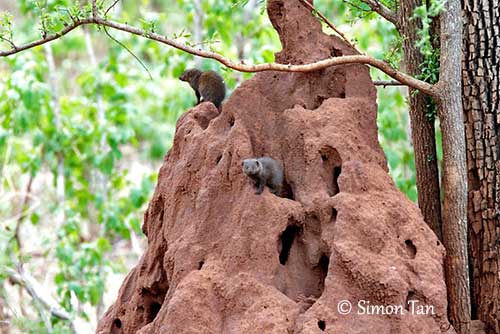
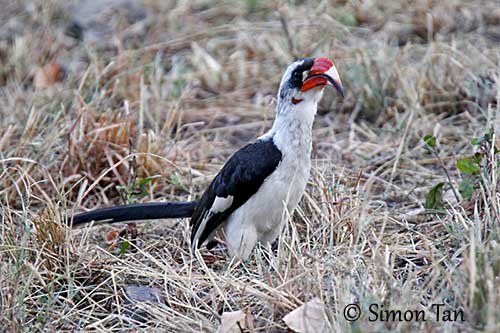
Dwarf Mongoose
(Helogale undulata)
The Von der Decken's Hornbill forages mainly on the ground, but also sometimes from perch. In this case, it drops down from the perch on to the prey.
When feeding on fruits, it can be seen perched high up in trees.
Small flocks of about 10 individuals are sometimes observed, but they are usually found in pairs while feeding on the ground.
These birds can be observed sunbathing, also bathing in the rain, tossing leaves or sticks and playing together, using their bills and jumping on or over each other.
At the beginning of the breeding season, the small African hornbills of genus Tockus perform territorial displays, especially the resident species which have a year-round territory.
The main display involves head bowed or raised, open wings and spread tail. This behaviour is accompanied by loud calls.
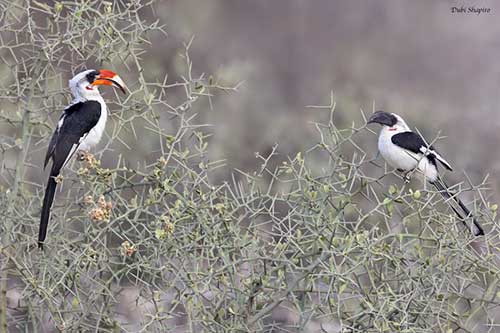
The Von der Decken's Hornbill is probably monogamous. It typically nests in tree cavity in which the female remains with the chicks while the male provide all the food through a narrow opening at nest entrance.
The Von der Decken's Hornbill is sedentary, with some wandering occurring during the droughts.
This species has short, broad, rounded wings efficient for short flights, but not for extended periods in the air.
The large, white wing panel is conspicuous during the undulating flight.
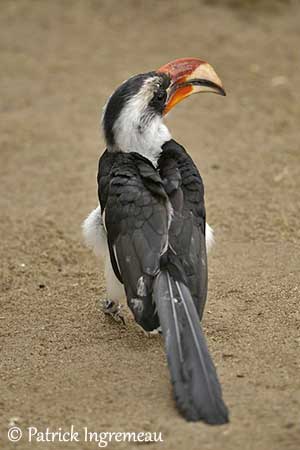
REPRODUCTION OF THIS SPECIES:
The laying takes place between January and July in Ethiopia and between November and March further south.
The male attracts the female to a tree cavity by offering her some food and mudding material. The female uses dirt and faeces to make the mudding which becomes very hard when dried. Then, she enters the cavity before closing the entrance with the help of the male, until a narrow slit is left open.
The female usually lays 2-3 white eggs, and incubates during about 46 days. The male provides her all the food and she also feeds the chicks with the food brought at nest by the male. It gives it to the female through the narrow slit.
During this period, the female moults both flight-feathers and rectrices at start of the laying, but after 3-4 weeks, she breaks out before the young and helps the male to feed them. When the young leave the nest, they are fully feathered, but they still depend on adults for food for one week more.
The main predators of both young and adults are the large raptors.
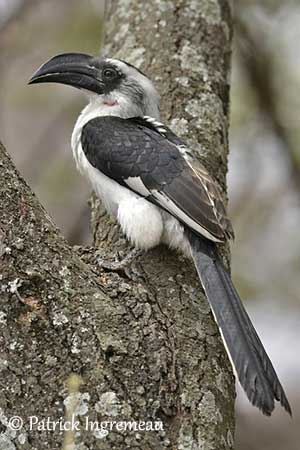
PROTECTION / THREATS / STATUS:
The Von der Decken's Hornbill is widespread and locally common. The species occurs in large reserves and national parks, and also in areas where the human density is low.
The birds living in areas where the nesting trees have been put down are affected by the lack of nesting sites which involves the decline of the population.
But currently, the Von der Decken's Hornbill is not globally threatened, and the species is evaluated as Least Concern.
